Paige Zabiela (4219)
Creative Reflection on Component 3
COMPONENT 3 BRIEF COMPLETED:
A promotion package for the release of an album, to include:
- a music video (major task)
- a social media page (minor task)
- a digipak (minor task)
CONTENTS:
- How do the elements of your production work together to create a sense of ‘branding’?
- How did your research inform your products and the way they use or challenge conventions?
- How do your products represent social groups or issues?
- How do your products engage with the audience?
Our music video, digipak and social media page act as a multimedia marketing campaign for our star and through these we have composed a brand. The mission statement of our marketing strategy is the promotion of “Being Yourself”, the ideology of self confidence in your own skin and not letting others bring you down, and so all of the micro features we have used is consistently shown throughout to create continuity and represent her star image as authentic throughout. We have encoded our marketing campaign, Hall’s theory, with elements which are used to communicate the message and present her star image. The preferred reading we are hoping for is one in which the audience sees their own anxieties, around self image and esteem, reflect in the star’s dilemma; the ordinary person which she is. Although each audience member will decode this to a slightly different reading of her; her branding is still a powerful, resilient individual who has the confidence to express a criticism of an unfair and cruel media representation.
We used the colour palette of red, black and white throughout. This continuity emphasises the lack of happiness created for individuals from the media, persisting to the audience that you must be yourself to be truly happy. This message being created breaks the blueprint of artists in the music industry as they are quite often forced to make the media and music industry seem golden, especially in the genre pop where everything is bright and upbeat, and so this confidence shown by our star to express her feelings creates her branding of inspiration and fortitude.
We also used bold statements such as the power stop pose she uses, the movement of her hiding herself in the music video and the passionate words (E.g. “the natural you is the best you!”) used in her social media posts. These bold actions present her extraordinary image as strong and helps inspire her audience to do the same; put up a defence and stick up for themselves. That they must put a stop to not being themselves and letting others knock them down.
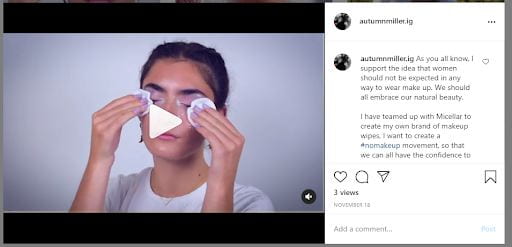
Micellar product endorsement Instagram post.
The repetition of the makeup in all three media products also emphasises and underlines to the audience the destruction which it causes and reinforces the metanarrative of being yourself.
The genre Indie/Pop has conventions of a narrative holding a message which is presented through a powerful star image and performance. The repertoire of elements according to Nick Lacey, which defines the genre, enabled us to define a blueprint for our music video; conventional features to fulfil our audience’s predictable pleasure, which they decode and can then accept the media. Examples of these conventions, which we identified from researching exemplar videos such as Sia’s “Elastic Heart” and Colbie Caillat’s “Fallin’ For You”, include an outdoor setting and more relaxed and neutral coloured clothes. This built a relationship between the artist and the audience as this contract which holds predictable pleasure also holds differences to allow the music video to stand out and allow the message to cause impact for them. For example, we used the settings of the outdoors and lots of makeup and hair to follow the typical generic conventions however when we inserted the idea of taking away the fake you (of being made up), this challenged the conventions and added dissimilarity as it broke the ideology of feminism and perfectionism. This ideology is also evolving with the change of modern media. Social media is becoming more intertwined in our daily lives which makes the critique we are presenting even more impacting.
We included our performers being made up with makeup and their hair being neatly plaited. This iconography follows the conventions of the pop genre in that the “perfect, glamourised and extraordinary” star image is being composed. This is expected from our audience however we used the actions; the facial expressions and body language of our star, which challenged the expectations of our genre. As Lacey stated; genre is an “act of similarity and difference” and so this difference allowed our music video to stand out thematically and reject the conventional star image, creating impact on our audience. This depressive mood we created through lack of smiling helped to express that perfectionism and
idealised life doesn’t bring happiness. We also used cuts of our models taking off their makeup to create a level of surprise and excitement for our audience as it was not the “predictable pleasure” expected. This unconventional act is presenting our star as an influential individual who shows her audience that being natural and yourself can bring the most happiness. This follows the Indie part of the genre more, challenging the pop dominant ideology, evervently presenting a message of “true self beauty” for the audience.
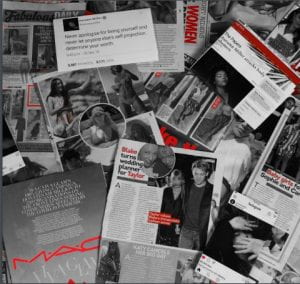
Media collage on the inside of our digipak.
We wanted to emphasise the issue and negative impact which the media, especially mainstream media, have on all of us; especially stars. This is strongly aimed at a young audience, especially women, digital natives and those who are passionate about the media representations and mental health issues: this being currently extremely prominent as the stigma surrounding mental health is being eroded. We accomplished this by encoding specific micro features to represent ideologies; something which Barthes theory covers. We also considered Dyer’s theory of the Paradox of the star, stating that through the metanarrative (E.g our digipak) the star is presented as both ‘ordinary and extraordinary’. We did this to represent her star image as being an influential individual who people inspire to be like but yet ordinary through her suffering and misrepresentations in the media so she still gains respect and has her own separate life.

Front cover of our digipak.
When editing our digipak on photoshop, we followed a colour palette of black and white with accents of red. This was not only a cultural code to represent the newspaper tabloids (E.g Sun) but also was a symbolic code to connote the idea of hatred and threat which the whole of media (i.e newspapers, social media, movies, etc) opposes . The jumbled, confused collage is also a symbolic code and denotes the relentless attention and scrutiny of the media. We used a high angle of our star, lying prone; a semic code signifying the intimidation stars feel from the media and the lack of control which they personally have over their own representations.. This shows her star image as an ordinary individual who is being victimised. The sans serif, bold typeface, with the strong dropshadow we chose culturally relates to a newspaper headline but also connotes a bold statement along with the word itself; making our audience feel the impact of the message being exhibited.
Our star was presented through our meta narrative as being both extraordinary and ordinary. For example we made her up with makeup to show a “perfect” star image yet we also wanted to present her as an ordinary person; shown in our music video with no makeup and being in the outdoors. Her pose was languourous and yet simulataneously adversarial which added to the representation of opposition against the media world and that she is human with a defiant voice which deserves to be heard from the mainstream media.
We created a social media page for our artist which has allowed her to build a relationship with her audience. The accessibility of being able to comment, like and share the posts enables social interaction, the portrayal of her life and likes and dislikes forms her metanarrative, impacting on her audiences own personal identity and the teasers and links to charities and news articles add excitement and gives them actionable information on how they can consume their star’s media output. This all covers Blumler and Katz’s “Uses and Gratification” theory.
Throughout our social media page, we posted teasers and snippets leading up to the release of the album. This enables the excitement to build and draws desire and interest from the audience. For example we added imperative phrases such as “big news” and “don’t miss out” to keep our audience engaged and feed their fear of missing out. We encoded certain shots and colour palettes (design coherences), such as the black, white and red, to link and hint to the release of the album.
Other posts we included were those on modern day issues. For example we emphasised the importance of true representation of yourself through linking to the ‘Hacked off’ group as well as the Pride Foundation charity and using synergy of product endorsement for Micellar Water; a makeup remover. These posts help to inform the audience about body positivity and it also helps to connote her star image as one that is confident and influential. These posts relate to the likes of her audience; young women and those passionate about modern issues such as mental health and body confidence.
As well as being socially interacted with her audience through commenting and engaging with the posts, we also used a live stream to add another aspect of engagement. This enables a real time involvement, one where the audience can 100% interact with the star. The build up to the album release is then backed up with links to youtube and other places where the audience can actively go and buy or download the album and songs.
All of these posts have the aim of spreading awareness of the star and her music not only from going viral online through the hashtags, sharing, liking, etc but also through physical word of mouth as well; the most positive part of earned media you can have.
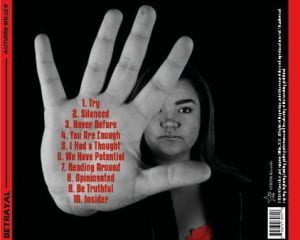


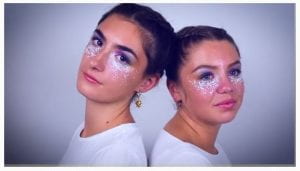




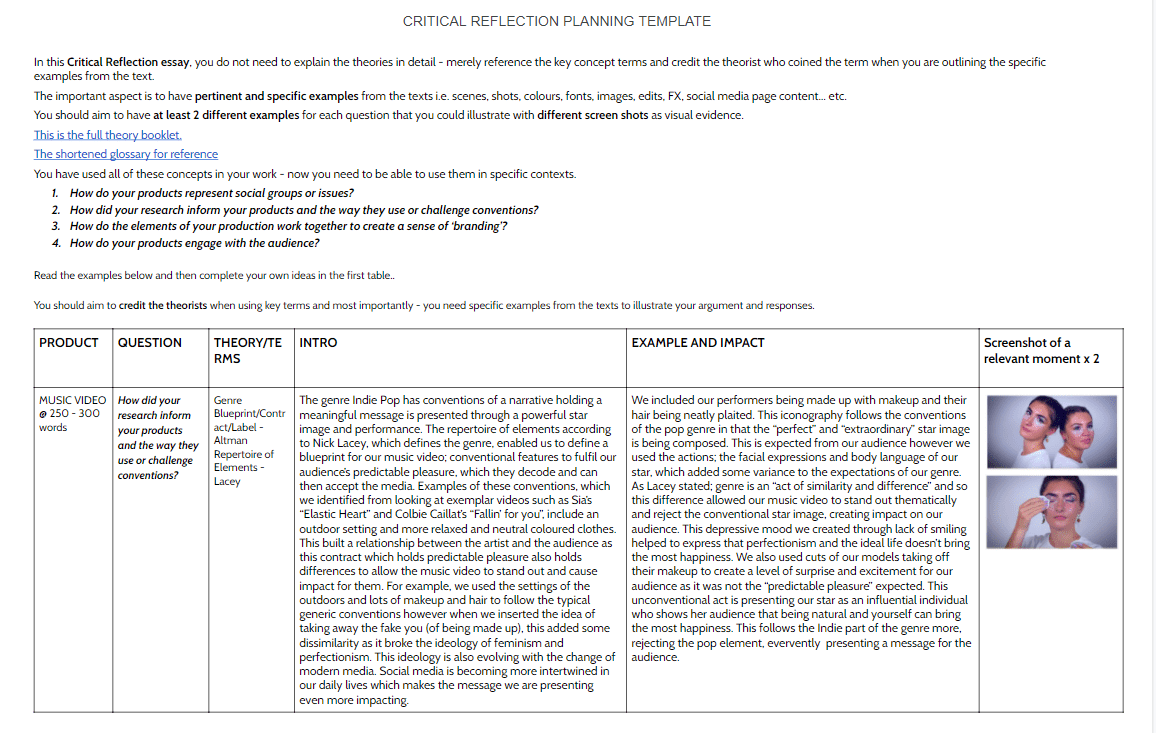




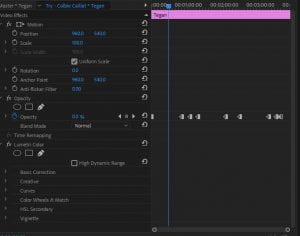


 We found that this was very useful when editing our music video as it enabled us to add interesting transitions that allowed one clip to cut and run smoothly into the next. The “dip to white” transition was especially useful in conveying the idea that a camera was flashing and taking a photo; representing the paparazzi’s photographing our music star.
We found that this was very useful when editing our music video as it enabled us to add interesting transitions that allowed one clip to cut and run smoothly into the next. The “dip to white” transition was especially useful in conveying the idea that a camera was flashing and taking a photo; representing the paparazzi’s photographing our music star. The filters were also very useful in portraying our overarching theme. At the beginning, a brighter filter was used (in the outside location) to show how our star is free and happy however this contrasts to the end when we use a black and white filter. This was chosen to show the unhappiness felt by our star when they are all full of make up and restricted from showing their true self.
The filters were also very useful in portraying our overarching theme. At the beginning, a brighter filter was used (in the outside location) to show how our star is free and happy however this contrasts to the end when we use a black and white filter. This was chosen to show the unhappiness felt by our star when they are all full of make up and restricted from showing their true self. We used the effect controls to mainly scale, position and rotate our shots. For example, we zoomed in on some of our shots to emphasize what we were showing. For example at the end, we have zoomed in on her eye which is dulled up with glitter and make up. This emphasizes how our artist has changed the way she looks to impress her audience. During the paparazzi sections, we used the rotational tool to position the pieces of film at different angles, emphasizing how stars are always trapped by paparazzi and that the have no space or time to themselves.
We used the effect controls to mainly scale, position and rotate our shots. For example, we zoomed in on some of our shots to emphasize what we were showing. For example at the end, we have zoomed in on her eye which is dulled up with glitter and make up. This emphasizes how our artist has changed the way she looks to impress her audience. During the paparazzi sections, we used the rotational tool to position the pieces of film at different angles, emphasizing how stars are always trapped by paparazzi and that the have no space or time to themselves.